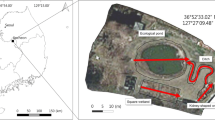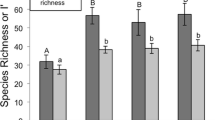Abstract
Habitat destruction caused by human activities is threatening wetland plants. Based on Landsat 5 TM, Landsat 8 OLI, and Google Earth images, we analysed the spatiotemporal dynamics of plant populations in a degraded wetland in the Minjiang River Estuary from 2009 to 2019. Field survey records, tasselled cap transformation, and supervised classification were used for the image interpretation. The results indicate that the plant habitat area decreased by 42.1% over these 10 years. Consequently, the distribution area of each dominant species declined, and the proportion of total vegetated area in the habitat decreased from 53.1% to 32.6%. Moreover, the dominance relations of the species changed from Spartina alterniflora > Phragmites australis > Cyperus malaccensis > Scirpus triqueter to P. australis > S. alterniflora > C. malaccensis > S. triqueter. We predict that the vegetation landscape in the wetland will be composed exclusively of P. australis and S. alterniflora if habitat destruction continues. Finally, our research shows that the NPCS (net plant carbon sequestration) and PCS (plant carbon stock) in the wetland and the average values of methane flux, NPCS, PCS, and SOCS (sediment organic carbon stock) in the vegetated area have all decreased due to plant population declines.


Similar content being viewed by others
References
An SQ, Gu BH, Zhou CF, Wang ZS, Deng ZF, Zhi YB, Li HL, Chen L, Yu DH, Liu YH (2007) Spartina invasion in China: implications for invasive species management and future research. Weed Research 47:183–191
Bai Y, Wong CP, Jiang B, Hughes AC, Wang M, Wang Q (2018) Developing China’s ecological redline policy using ecosystem services assessments for land use planning. Nature Communications 9:3034
Baig MHA, Zhang LF, Shuai T, Tong QX (2014) Derivation of a tasselled cap transformation based on Landsat 8 at-satellite reflectance. Remote Sensing Letters 5:423–431
Bedford BL, Leopold DJ, Gibbs JP (2013) Wetlands ecosystems. In: Levin SA (ed) Encyclopedia of biodiversity, vol 7, 2nd edn. Academic Press, San Diego, pp 384–402
Bridgham SD, Megonigal JP, Keller JK, Norman BB, Trettin C (2006) The carbon balance of north American wetlands. Wetlands 26:889–916
Cheng YR, Tong C, Du DD, Tan LS, Li HF, Rao QH (2018) Modelling the diurnal variations of methane emissions from the Cyperus malaccensis tidal marsh in the Minjiang River estuary. Wetlands 38:293–305
Chung CH (2006) Forty years of ecological engineering with Spartina plantations in China. Ecological Engineering 27:49–57
Conrad C, Fritsh S, Zeidler J, Rücker G, Dech S (2010) Per-field irrigated crop classification in arid Central Asia using SPOT and ASTER data. Remote Sensing 2:1035–1056
Crist EP, Laurin R, Cicone RC (1986) Vegetation and soils information contained in transformed thematic mapper dada. In: Proceedings of IGARSS’ 86 symposium. ESA Publication Division, Noordwijk, pp 1465–1470
Cui LL, Li GS, Ouyang NL, Mu FY, Yan F, Zhang YT, Huang XY (2018) Analyzing coastal wetland degradation and its key restoration technologies in the coastal area of Jiangsu, China. Wetlands 38:525–537
Davidson NC (2014) How much wetland has the world lost? Long-term and recent trends in global wetland area. Marine and Freshwater Research 65:934–941
Deane DC, Fordham DA, He FL, Bradshaw CJA (2017) Future extinction risk of wetland plants is higher from individual patch loss than total area reduction. Biological Conservation 209:27–33
Dyer AR, Rice KJ (1999) Effects of competition on resource availability and growth of a California bunchgrass. Ecology 80:2697–2710
Forsyth SA (2003) Density-dependent seed set in the Haleakala silversword: evidence for an Allee effect. Oecologia 136:551–557
Goldberg DE, Barton AM (1992) Patterns and consequences of interspecific competition in natural communities: a review of field experiments with plants. The American Naturalist 139:771–801
Groom MJ (1998) Allee effects limit population viability of an annual plant. The American Naturalist 151:487–496
Guo XD, Chang Q, Liu X, Bao HM, Zhang YP, Tu XY, Zhu CX, Lv CY, Zhang YY (2018) Multi-dimensional eco-land classification and management for implementing the ecological redline policy in China. Land Use Policy 74:15–31
Hall LS, Krausman PR, Morrison ML (1997) The habitat concept and a plea for standard terminology. Wildlife Society Bulletin 25:173–182
Han M, Cui JL, Hao Z, Wang Y, Wang RQ (2012) Eco-compensation of wetland in Yellow River Delta of Shandong Province, China. Chinese Geographical Science 22:119–126
Henle K, Davies KF, Kleyer M, Margules C, Settele J (2004) Predictors of species sensitivity to fragmentation. Biodiversity and Conservation 13:207–251
Huang WJ (2008) Study on carbon storage in Minjiang River estuary. Dissertation, Fujian Agriculture and Forestry University (in Chinese with English abstract)
Huang HM, Zhang LQ (2007) A study of the population dynamics of Spartina alterniflora at Jiuduansha shoals, Shanghai, China. Ecological Engineering 29:164–172
IPCC (2014) Climate change 2013: the physical science basis. Working group I contribution to the fifth assessment report of the intergovernmental panel on climate change. Cambridge University Press, Cambridge
Jia RX, Tong C, Wang WQ, Zeng CS (2008) Organic carbon contents and storages in the salt marsh sediments in the Min River estuary. Wetland Science 6:492–499 (in Chinese with English abstract)
Johnson BB, Pflugh KK (2008) Local officials’ and citizens’ views on freshwater wetlands. Society and Natural Resources 21:387–403
Joshi J, Stoll P, Rusterholz HP, Schmid B, Dolt C, Baur B (2006) Small-scale experimental habitat fragmentation reduces colonization rates in species-rich grasslands. Oecologia 148:144–152
Lai WL, Zhang Y, Chen ZH (2012) Radial oxygen loss, photosynthesis, and nutrient removal of 35 wetland plants. Ecological Engineering 39:24–30
Liao CZ, Luo YQ, Jiang LF, Zhou XH, Wu XW, Fang CM, Chen JK, Li B (2007) Invasion of Spartina alterniflora enhanced ecosystem carbon and nitrogen stocks in the Yangtze estuary, China. Ecosystems 10:1351–1361
Liu QS, Liu GH, Huang C, Xie CJ (2015) Comparison of tasselled cap transformations based on the selective bands of Landsat 8 OLI TOA reflectance images. International Journal of Remote Sensing 36:417–441
Matthies D, Bräuer I, Maibom W, Tscharntke T (2004) Population size and the risk of local extinction: empirical evidence from rare plants. OIKOS 105:481–488
Niering WA (1988) Endangered, threatened and rare wetland plants and animals of the continental United States. In: Hook DD, McKee WH Jr, Smith HK, Gregory J, Burrell VG Jr, DeVoe MR, Sojka RE, Gilbert S, Banks R, Stolzy LH, Brooks C, Matthews TD, Shear TH (eds) The ecology and management of wetlands, volume 1: ecology of wetlands. Timber Press, Portland, pp 227–238
Roberts MJ, Long SP, Tieszen LL, Beadle CL (1993) Measurement of plant biomass and net primary production of herbaceous vegetation. In: Hall DO, Scurlock JMO, Bolhàr-Nordenkampf HR, Leegood RC, Long SP (eds) Photosynthesis and production in a changing environment, A Field and Laboratory Manual. Chapman and Hall, London, pp 1–21
Santra A, Mitra SS (2014) A comparative study of tasselled cap transformation of DMC and ETM+ images and their application in forest classification. Journal of the Indian Society of Remote Sensing 42:373–381
Shang WX, Gong YC, Wang ZJ, Stewardson MJ (2018) Eco-compensation in China: theory, practices and suggestions for the future. Journal of Environmental Management 210:162–170
Son NT, Thanh BX, Da CT (2016) Monitoring mangrove forest changes from multi-temporal Landsat data in can Gio biosphere reserve, Vietnam. Wetlands 36:565–576
Soons MB, Messelink JH, Jongejans E, Heil GW (2005) Habitat fragmentation reduces grassland connectivity for both short-distance and long-distance wind-dispersed forbs. Journal of Ecology 93:1214–1225
Stephens PA, Sutherland WJ, Freckleton RP (1999) What is the Allee effect? OIKOS 87:185–190
Tan YH, Lv DA, Cheng J, Wang D, Mo W, Xiang YY (2018) Valuation of environmental improvements in coastal wetland restoration: a choice experiment approach. Global Ecology and Conservation 15:e00440
Tilman D (1994) Competition and biodiversity in spatially structured habitats. Ecology 75:2–16
Tong C, Wang WQ, Zeng CS, Marrs R (2010) Methane (CH4) emission from a tidal marsh in the Min River estuary, Southeast China. Journal of Environmental Science and Health Part A 45:506–516
Tong C, Wang WQ, Huang JF, Gauci V, Zhang LH, Zeng CS (2012) Invasive alien plants increase CH4 emissions from a subtropical tidal estuarine wetland. Biogeochemistry 111:677–693
Tong C, Wang C, Huang JF, Wang WQ, E Y, Liao J, Yao C (2014) Ecosystem respiration does not differ before and after tidal inundation in brackish marshes of the Min River estuary, Southeast China. Wetlands 34:225–233
Walter BP, Heimann M (2000) A process-based, climate-sensitive model to derive methane emissions from natural wetlands: application to five wetland sites, sensitivity to model parameters, and climate. Global Biogeochemical Cycles 14:745–765
Wang WQ, Tong C, Jia RX, Zeng CS (2010) Ecological stoichiometry characteristics of wetland soil carbon, nitrogen and phosphorus in different water-flooded frequency. Journal of Soil and Water Conservation 24:238–242 (in Chinese with English abstract)
Wang WQ, Wang C, Sardans J, Zeng CS, Tong C, Peñuelas J (2015) Plant invasive success associated with higher N-use efficiency and stoichiometric shifts in the soil-plant system in the Minjiang River tidal estuarine wetlands of China. Wetlands Ecology and Management 23:865–880
Xiang J, Liu DY, Ding WX, Yuan JJ, Lin YX (2015) Invasion chronosequence of Spartina alterniflora on methane emission and organic carbon sequestration in a coastal salt marsh. Atmospheric Environment 112:72–80
Zeng CS, Lei B, Wang WQ, Tong C, Ai JQ, Zhang WL (2009) Methane emission from Scirpus triqueter wetland in the Min River estuary. Wetland Science 7:142–147 (in Chinese with English abstract)
Zhang LH (2008) Net primary productivity and nitrogen and phosphorus dynamics of dominant plants in the wetland of Minjiang River estuary. Dissertation, Fujian Normal University (in Chinese with English abstract)
Zhu QL (2017) Carbon, nitrogen and phosphorus ecological stoichiometry characteristics of herbs in the coastal wetland of Fujian, Zhejiang and Shanghai. Dissertation, Fujian Normal University (in Chinese with English abstract)
Acknowledgements
This work was supported by Nanjing Normal University, Fujian Normal University, and the National Natural Science Foundation of China (No. 41671428). We sincerely thank the editors and the anonymous reviewers for their valuable comments and suggestions for this manuscript.
Author information
Authors and Affiliations
Corresponding author
Additional information
Publisher’s Note
Springer Nature remains neutral with regard to jurisdictional claims in published maps and institutional affiliations.
Rights and permissions
About this article
Cite this article
Cheng, Y., Zha, Y., Tong, C. et al. Plant Population Dynamics in a Degraded Coastal Wetland and Implications for the Carbon Cycle. Wetlands 40, 1617–1625 (2020). https://doi.org/10.1007/s13157-020-01268-7
Received:
Accepted:
Published:
Issue Date:
DOI: https://doi.org/10.1007/s13157-020-01268-7




